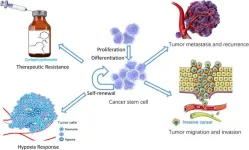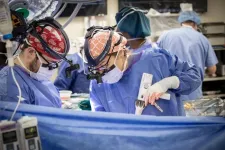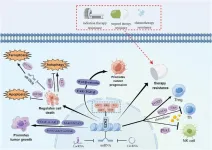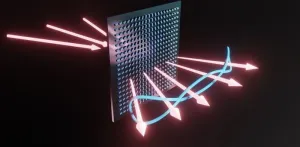(Press-News.org) Humans may not be the only ones who aid their friends when they’re hurt. Mice may do it, too, as shown by a new research study led by scientists at the Keck School of Medicine of USC published recently in Science.
Scientists have been trying to understand why social mammals appear to help injured members of their species. There are numerous factors that determine empathetic behavior and social bonding in mammals, said Li Zhang, the principal investigator of the study and professor of physiology and neuroscience at Keck School of Medicine. “But this study is the first time we’re seeing a first responder-like behavior in mice.”
Emergency response
The study shows that mice tend to help other mice they know are unconscious. Their response ranges from gentle sniffing and grooming to more forceful actions such as mouth or tongue biting, before finally escalating to pulling the tongue out of the unconscious mouse.
“The behavior was especially unique due to its similarity to how humans behave in emergency responses,” said Wenjian Sun, the first author of the study and research associate at Keck School of Medicine’s Zilkha Neurogenetic Institute. “I had never seen this behavior from mice before.”
Interestingly, the scientists discovered this behavior by accident. Sun first witnessed the rehabilitative behavior among mice paired together in an unrelated scientific study. When humans encounter an unconscious individual, the emergency response is varied, including assessing the situation, checking responsiveness, calling for help and performing cardiopulmonary resuscitation, or CPR, on an individual.
Helper mice
The urgency with which “helper mice” target the mouth and tongue of their unconscious peers appears to improve the airway of their peer and lead to a faster recovery, said Huizhong Tao, an author of the study and professor of physiology and neuroscience at Keck School of Medicine.
Tao pointed out that the scientists learned the act of tongue-pulling between mice in this study could not be interpreted as an aggressive gesture. The social behaviors in the study were significantly more pronounced among familiar pairs of mice and were rarely seen when one of the paired mice was simply sleeping or active. Furthermore, after the unconscious mice regained consciousness, they had regular use of their tongue.
The role of oxytocin
The study utilized advanced neural imaging and optogenetics to investigate the neural mechanisms behind the social behaviors of the helper mice. Zhang said one of the most intriguing aspects of the research team’s neural observations was the discovery of the activation of oxytocin neuropeptides. Oxytocin is widely known as a hormone that plays a crucial role in social bonding.
Oxytocin is sometimes called the “love hormone” because it is associated with feelings of trust, bonding and affection. Zhang said this was the first study to show oxytocin may also be a key factor in the social bonding in mice. The study’s findings not only enhance our understanding of animal behavior but also highlight the critical role of the oxytocin system, which may also inform social behaviors across vertebrate species.
Further implications
The research team plans to run longer experiments in the future to see if mice have even more complex responses to their unconscious peers. Tao believes this discovery opens exciting new ways to study the biological foundations of prosocial behaviors, including empathy.
This research suggests many social animals, including humans, might have evolved to help each other in critical situations, improving survival chances and strengthening social bonds.
About the study: In addition to Sun, Zhang and Tao, other study authors include Guangwei Zhang, Junxiang J. Huang, Can Tao and Michelle B. Seo of Keck School of Medicine.
This research was supported by the U.S. National Institutes of Health (EY019049, AG089756, DC008983, DC020887, NS132912).
END
USC researchers observe mice may have a form of first aid
Keck School of Medicine of USC researchers discover through happenstance that mice have their own form of ‘first aid’ practices to help other mice in need.
2025-03-08
ELSE PRESS RELEASES FROM THIS DATE:
VUMC to develop AI technology for therapeutic antibody discovery
2025-03-07
An ambitious project led by Vanderbilt University Medical Center investigators aims to use artificial intelligence technologies to generate antibody therapies against any antigen target of interest.
VUMC has been awarded up to $30 million from the Advanced Research Projects Agency for Health (ARPA-H) to build a massive antibody-antigen atlas, develop AI-based algorithms to engineer antigen-specific antibodies, and apply the AI technology to identify and develop potential therapeutic antibodies.
ARPA-H is an ...
Unlocking the hidden proteome: The role of coding circular RNA in cancer
2025-03-07
A new review article highlights the transformative role of circular RNA (circRNA) in cancer, revealing its potential as both a key player in tumor biology and a promising avenue for future therapies. Once thought to be noncoding RNA, circRNA has now been shown to encode functional proteins, challenging conventional RNA biology and opening up novel therapeutic possibilities.
Unlike traditional messenger RNA, circRNAs form a continuous loop, lacking the typical 5' cap and 3' tail. This unique structure was originally believed to preclude them from protein translation. However, recent discoveries demonstrate that specific internal ribosome entry sites (IRES) and N6-methyladenosine ...
Advancing lung cancer treatment: Understanding the differences between LUAD and LUSC
2025-03-07
Lung cancer remains one of the leading causes of cancer-related mortality, with lung adenocarcinoma (LUAD) and lung squamous cell carcinoma (LUSC) representing the most prevalent subtypes of non-small cell lung cancer (NSCLC). Despite their classification under the same umbrella, these two forms of lung cancer exhibit distinct genetic landscapes, therapeutic targets, and treatment responses.
Recent advancements in next-generation gene sequencing have identified key driver genes that differentiate LUAD and LUSC, influencing their respective clinical management approaches. LUAD is frequently associated ...
Study reveals widening heart disease disparities in the US
2025-03-07
A study published March 6 in The Lancet Regional Health — Americas highlights a growing divide in cardiovascular health in the U.S., showing that wealth and education play a significant role in heart disease risk.
The research, led by Salma Abdalla, MBBS, DrPH, an assistant professor of public health at Washington University in St. Louis, reveals that the top 20% of high-income, college-educated Americans have far lower rates of cardiovascular disease than the rest of the population — disparities ...
The role of ubiquitination in cancer stem cell regulation
2025-03-07
This review highlights the critical role of ubiquitination in governing the functionality of cancer stem cells (CSCs), shedding light on potential therapeutic targets for combating tumor progression, recurrence, and drug resistance. Published in Genes & Diseases, this article explores the intricate mechanisms through which the ubiquitin (Ub) system regulates key pathways essential for CSC maintenance and survival.
Ubiquitination, a fundamental post-translational modification, plays a pivotal role in protein stability, cellular signaling, and gene expression, particularly in the context of CSCs. Dysregulation ...
New insights into LSD1: a key regulator in disease pathogenesis
2025-03-07
A new review highlights the pivotal role of LSD1 (lysine-specific demethylase 1) in regulating critical cellular processes and its implications for human diseases. This article sheds light on how post-translational modifications (PTMs) influence LSD1 activity, impacting its function in gene regulation and disease progression.
LSD1 is a histone demethylase that plays a significant role in chromatin remodeling and gene expression by modifying histone H3 lysine residues. It interacts with various protein complexes, allowing it to serve as both a transcriptional activator and repressor. The intricate modifications ...
Vanderbilt lung transplant establishes new record
2025-03-07
Surgeons and teams with Vanderbilt Lung Transplant performed 99 lung transplants in 2024, the most ever in one year. Two of the procedures involved combined organ transplants.
For the second calendar year in a row, Vanderbilt Lung Transplant has the busiest program in the Southeast and leads the nation in innovation in organ preservation and regeneration.
The Vanderbilt Transplant Center is now home to the nation’s eighth largest lung transplant program by volume, and is among the best in long-term outcomes, demonstrating the ...
Revolutionizing cancer treatment: targeting EZH2 for a new era of precision medicine
2025-03-07
The critical role of EZH2, an essential epigenetic regulator, in cancer progression and treatment is underscored in this new review article published in Genes & Diseases. The study highlights the transformative potential of EZH2 inhibition, paving the way for a new generation of targeted therapies aimed at disrupting tumor growth and overcoming treatment resistance.
EZH2, a core component of the Polycomb Repressive Complex 2 (PRC2), plays a fundamental role in silencing tumor suppressor genes through histone methylation. Its overexpression has been ...
Metasurface technology offers a compact way to generate multiphoton entanglement
2025-03-07
Quantum information processing is a field that relies on the entanglement of multiple photons to process vast amounts of information. However, creating multiphoton entanglement is a challenging task. Traditional methods either use quantum nonlinear optical processes, which are inefficient for large numbers of photons, or linear beam-splitting and quantum interference, which require complex setups prone to issues like loss and crosstalk.
A team of researchers from Peking University, Southern University of Science and Technology, and the University of Science and Technology of China recently made ...
Effort seeks to increase cancer-gene testing in primary care
2025-03-07
Up to 10% of cancers are caused by genes that can be easily detected by commercially available tests. These include such common cancers as cancer of the breast, ovary, colon, stomach, uterus and pancreas.
“We don’t routinely screen for cancer susceptibility genes in primary-care settings because genetic testing is often considered too complicated and primary care doctors already have so many things they need to address,” noted lead author Dr. Elizabeth Swisher, a UW Medicine gynecological oncologist. "But it is an opportunity lost.”
In the JAMA Network Open study published ...
LAST 30 PRESS RELEASES:
First Editorial of 2026: Resisting AI slop
Joint ground- and space-based observations reveal Saturn-mass rogue planet
Inheritable genetic variant offers protection against blood cancer risk and progression
Pigs settled Pacific islands alongside early human voyagers
A Coral reef’s daily pulse reshapes microbes in surrounding waters
EAST Tokamak experiments exceed plasma density limit, offering new approach to fusion ignition
Groundbreaking discovery reveals Africa’s oldest cremation pyre and complex ritual practices
First breathing ‘lung-on-chip’ developed using genetically identical cells
How people moved pigs across the Pacific
Interaction of climate change and human activity and its impact on plant diversity in Qinghai-Tibet plateau
From addressing uncertainty to national strategy: an interpretation of Professor Lim Siong Guan’s views
Clinical trials on AI language model use in digestive healthcare
Scientists improve robotic visual–inertial trajectory localization accuracy using cross-modal interaction and selection techniques
Correlation between cancer cachexia and immune-related adverse events in HCC
Human adipose tissue: a new source for functional organoids
Metro lines double as freight highways during off-peak hours, Beijing study shows
Biomedical functions and applications of nanomaterials in tumor diagnosis and treatment: perspectives from ophthalmic oncology
3D imaging unveils how passivation improves perovskite solar cell performance
Enriching framework Al sites in 8-membered rings of Cu-SSZ-39 zeolite to enhance low-temperature ammonia selective catalytic reduction performance
AI-powered RNA drug development: a new frontier in therapeutics
Decoupling the HOR enhancement on PtRu: Dynamically matching interfacial water to reaction coordinates
Sulfur isn’t poisonous when it synergistically acts with phosphine in olefins hydroformylation
URI researchers uncover molecular mechanisms behind speciation in corals
Chitin based carbon aerogel offers a cleaner way to store thermal energy
Tracing hidden sources of nitrate pollution in rapidly changing rural urban landscapes
Viruses on plastic pollution may quietly accelerate the spread of antibiotic resistance
Three UH Rainbow Babies & Children’s faculty elected to prestigious American Pediatric Society
Tunnel resilience models unveiled to aid post-earthquake recovery
Satellite communication systems: the future of 5G/6G connectivity
Space computing power networks: a new frontier for satellite technologies
[Press-News.org] USC researchers observe mice may have a form of first aidKeck School of Medicine of USC researchers discover through happenstance that mice have their own form of ‘first aid’ practices to help other mice in need.







